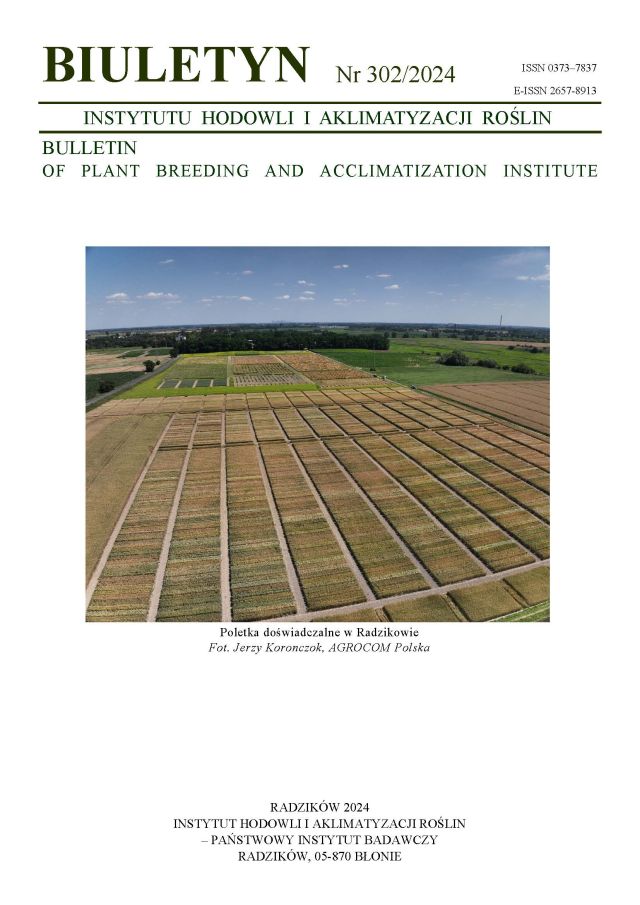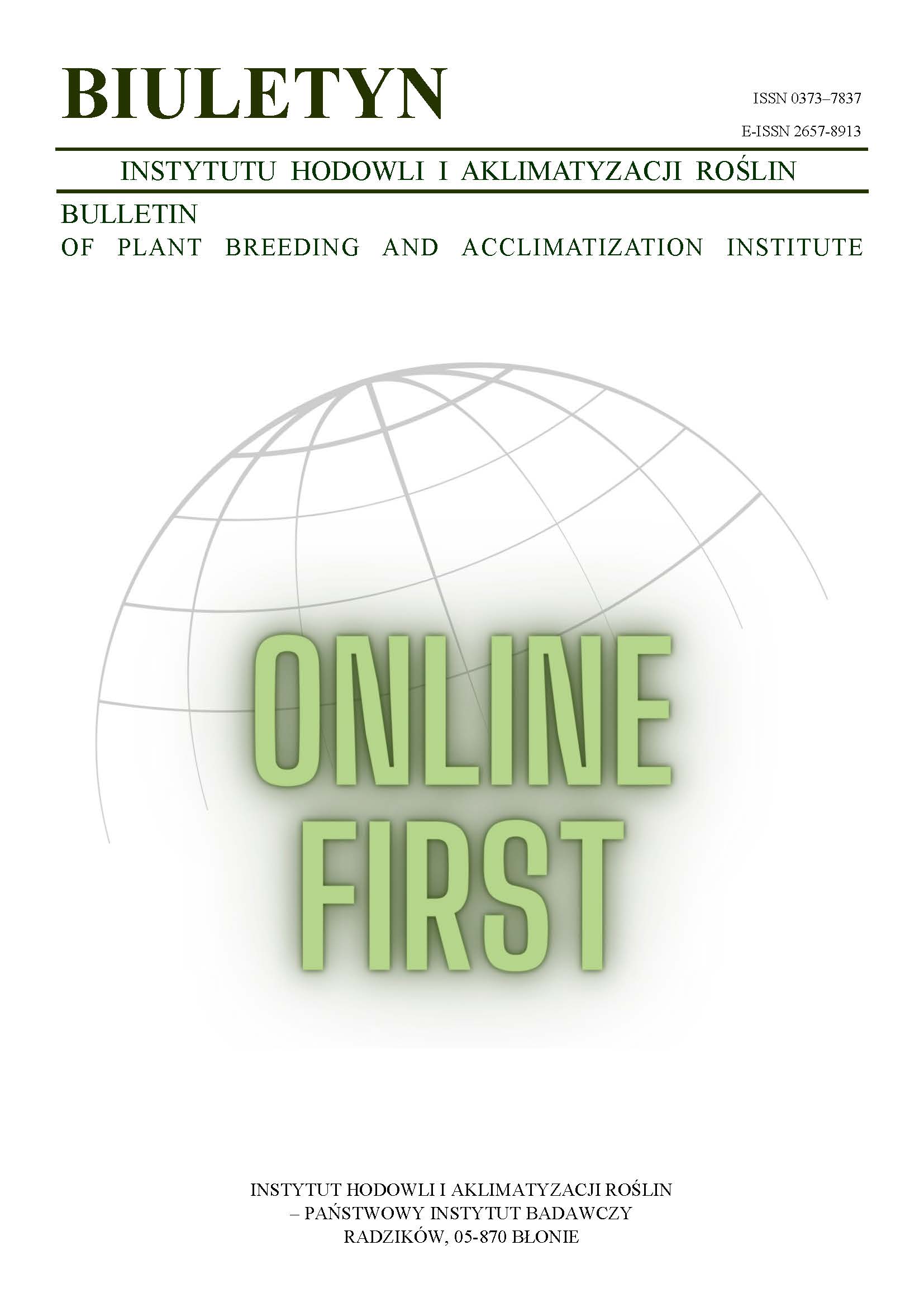Combining abilities of several varieties of linseed with respect to yield components
Halina Góral
wrol@urk.edu.plKatedra Hodowli Roślin i Nasiennictwa, Akademia Rolnicza w Krakowie (Poland)
Michał Jasieński
Katedra Hodowli Roślin i Nasiennictwa, Akademia Rolnicza w Krakowie (Poland)
Tadeusz Zając
Katedra Szczegółowej Uprawy Roślin, Akademia Rolnicza w Krakowie (Poland)
Abstract
The study was aimed at evaluating the general (GCA) and specific (SCA) combining abilities and the effects of reciprocal crosses among several varieties of linseed (of different geographic origin), with respect to yield components. We have documented the existence of significant variation in both GCA and SCA for yield components. Reciprocal crosses resulted in significant effects for plant height. The varieties LinolaTM 947 and ‘Opal’ were characterised by significant positive combining abilities for plant height and number of capsules per plant, which implies that with these two varieties selection in early hybrid generations should be effective. The varieties LinolaTM 947 and Barbara can be recommended for recombination breeding aimed at increasing the seed yield, since their GCA for the number of capsules per plant and weight of 1000 seeds are opposite in sign, and they both have positive GCA for seed number per capsule. A reciprocal cross effect for plant height, capsule number and seed weight per plant was recorded for the cross between LinolaTM 947 and Barbara. This result indicates that the direction of crosses is important for the characteristics of the hybrids, which indicates that cytoplasmatic factors may be important in the inheritance of this trait.
Keywords:
combining ability, linseed, yield componentsReferences
Anand I. J., Murty B.R. 1969. Serial analysis of combining ability in diallel and fractional diallel crosses in linseed. Theor. Appl. Genet. 39: 88 — 94.
DOI: https://doi.org/10.1007/BF00307722
Google Scholar
Foster R., Pooni H. S., Mackay I. J. 1998. Quantitative analysis of Linum usitatissimum crosses for dual-purpose traits. J. Agron. Sci. 131: 285 — 292.
DOI: https://doi.org/10.1017/S0021859698005917
Google Scholar
Patil V. D., Chopde P. R. 1981. Combining ability analysis over environments in diallel crosses of linseed (Linum usitatissimum). Theor. Appl. Genet. 60: 339 — 343.
DOI: https://doi.org/10.1007/BF00264325
Google Scholar
Piotrowska A., Furowicz B. 1998. Postęp w hodowli lnu oleistego. Rośliny Oleiste XIX: 641 — 643.
Google Scholar
Szczucińska A., Szulc A., Klukowska-Majewska Z. 1995. Olej lniany jako surowiec kosmetyczny. Rośliny Oleiste XVI: 341 — 344.
Google Scholar
Tyson H. 1989. Genetic control of seed weight in flax (Linum usitatissimum) and possible implications. Theor. Appl. Genet. 77: 260 — 270.
DOI: https://doi.org/10.1007/BF00266196
Google Scholar
Zając T. 2004. Współczesne uwarunkowania uprawy i wykorzystania lnu oleistego. Post. Nauk Roln. 2: 77 — 91.
Google Scholar
Authors
Halina Góralwrol@urk.edu.pl
Katedra Hodowli Roślin i Nasiennictwa, Akademia Rolnicza w Krakowie Poland
Authors
Michał JasieńskiKatedra Hodowli Roślin i Nasiennictwa, Akademia Rolnicza w Krakowie Poland
Authors
Tadeusz ZającKatedra Szczegółowej Uprawy Roślin, Akademia Rolnicza w Krakowie Poland
Statistics
Abstract views: 85PDF downloads: 23
License
Copyright (c) 2006 Halina Góral, Michał Jasieński, Tadeusz Zając

This work is licensed under a Creative Commons Attribution-ShareAlike 4.0 International License.
Upon submitting the article, the Authors grant the Publisher a non-exclusive and free license to use the article for an indefinite period of time throughout the world in the following fields of use:
- Production and reproduction of copies of the article using a specific technique, including printing and digital technology.
- Placing on the market, lending or renting the original or copies of the article.
- Public performance, exhibition, display, reproduction, broadcasting and re-broadcasting, as well as making the article publicly available in such a way that everyone can access it at a place and time of their choice.
- Including the article in a collective work.
- Uploading an article in electronic form to electronic platforms or otherwise introducing an article in electronic form to the Internet or other network.
- Dissemination of the article in electronic form on the Internet or other network, in collective work as well as independently.
- Making the article available in an electronic version in such a way that everyone can access it at a place and time of their choice, in particular via the Internet.
Authors by sending a request for publication:
- They consent to the publication of the article in the journal,
- They agree to give the publication a DOI (Digital Object Identifier),
- They undertake to comply with the publishing house's code of ethics in accordance with the guidelines of the Committee on Publication Ethics (COPE), (http://ihar.edu.pl/biblioteka_i_wydawnictwa.php),
- They consent to the articles being made available in electronic form under the CC BY-SA 4.0 license, in open access,
- They agree to send article metadata to commercial and non-commercial journal indexing databases.
Most read articles by the same author(s)
- Stefan Stojałowski , Marta Orłowska , Martyna Sobczyk , Anna Bienias , Marcin Berdzik , Beata Myśków , Halina Góral , Magdalena Simlat , Tomasz Warzecha , Wojciech Wesołowski , Marek Szklarczyk , Mirosław Pojmaj , Genetic background of male sterility in triticale with different cytoplasm’s and perspectives of it utilization for development of CMS system in wheat , Bulletin of Plant Breeding and Acclimatization Institute: No. 286 (2019): Special issue
- Halina Góral, Male fertility of winter triticale depending on the cytoplasm and male parent , Bulletin of Plant Breeding and Acclimatization Institute: No. 269 (2013): Regular issue
- Halina Góral, Maciej Ejsmond, Combining ability analysis and heritability of yield components in linseed (Linum usitatissimum L.) , Bulletin of Plant Breeding and Acclimatization Institute: No. 249 (2008): Regular issue
- Halina Góral, Mirosław Pojmaj, Renata Pojmaj, Monika Burczy, Production of hybrid seeds of winter triticale from cms and restoring lines in strip and bulk sowing , Bulletin of Plant Breeding and Acclimatization Institute: No. 252 (2009): Regular issue
- Halina Góral, Mirosław Pojmaj, Renata Pojmaj, Frequency of maintainer and restorer genotypes for the cms-T. timopheevi system winter triticale , Bulletin of Plant Breeding and Acclimatization Institute: No. 244 (2007): Regular issue
- Elżbieta Pisulewska, Julita Maciejewicz-Ryś, Halina Góral, Yield, chemical composition and protein quality in long flower head forms of red clover (Trifolium pratense L.) , Bulletin of Plant Breeding and Acclimatization Institute: No. 228 (2003): Regular issue
- Tomasz Warzecha, Halina Góral, Susceptibility of auto- and alloplasmic triticale lines to seedling blight caused by Fusarium culmorum (W.G.Sm.) Sacc. , Bulletin of Plant Breeding and Acclimatization Institute: No. 236 (2005): Regular issue
- Halina Góral, Jadwiga Przypadek, Ludwik Spiss, Selection of red clover (Trifolium pratense L.) with regard to length and number of flower heads , Bulletin of Plant Breeding and Acclimatization Institute: No. 226/227 (2003): Regular issue
- Halina Góral, Ludwik Spiss, Development of maintainer and restorer genotypes for cms-T. timopheevi system in spring triticale , Bulletin of Plant Breeding and Acclimatization Institute: No. 236 (2005): Regular issue
- Tomasz Warzecha, Halina Góral, Combining ability of cms lines, strains and cultivars of triticale for susceptibility to seedling blight caused by Fusarium culmorum , Bulletin of Plant Breeding and Acclimatization Institute: No. 240/241 (2006): Regular issue














